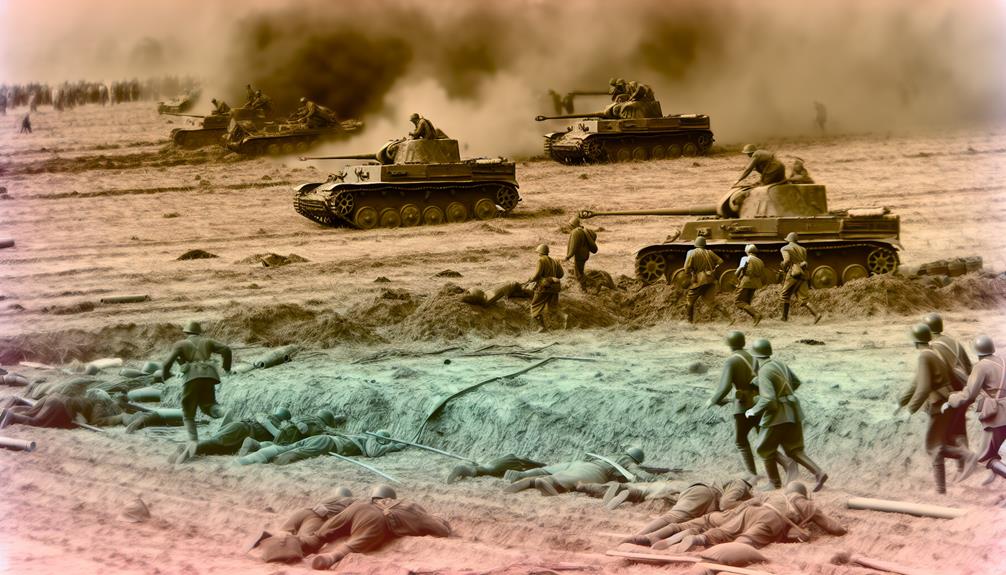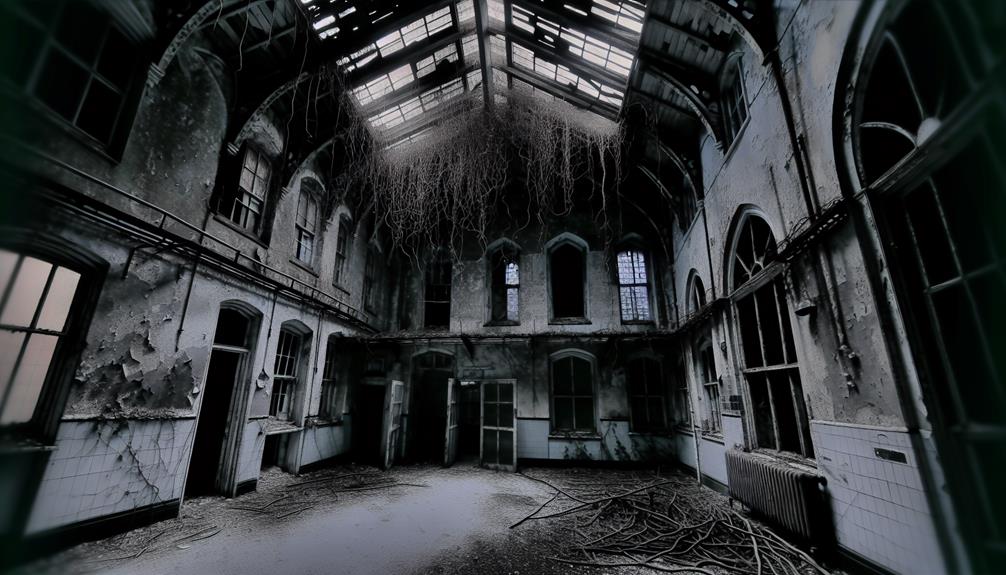The Battle of Kursk stands as a defining moment in the annals of military history, a clash of monumental proportions that reverberated far beyond the battlefields of World War II. The strategic intricacies, the sheer scale of armored might, and the relentless push and pull of two formidable adversaries locked in a deadly embrace continue to captivate historians and military strategists alike. As the dust settled over the vast expanse of the Kursk salient, the ramifications of this titanic struggle would echo through the corridors of power, shaping the future of warfare in ways unforeseen.
Key Takeaways
- Battle of Kursk was the largest tank battle in history.
- German offensive focused on armored divisions and breakthrough tactics.
- Soviets fortified Kursk with a multi-layered defense system.
- Tank warfare dynamics featured Tiger and Panther tanks vs. T-34s.
- Battle's strategic importance led to a shift in momentum and a Soviet counterattack.
Prelude to the Battle
In the lead-up to the Battle of Kursk, a strategic stronghold was being meticulously fortified and prepared by both the German and Soviet forces, laying the groundwork for one of the most pivotal confrontations in World War II. The region of Kursk held immense importance due to its strategic positioning, being a key transportation hub and providing access to critical resources. Both sides recognized the significance of this area and engaged in a massive build-up of forces in preparation for the impending clash.
The Soviet Union, having suffered significant losses earlier in the war, was determined to defend its territory and push back against the German advance. Under the leadership of Marshal Georgy Zhukov, the Soviets strategically positioned their troops, constructed elaborate defensive fortifications, and set up an intricate network of mines and obstacles to impede the enemy's progress.
On the other side, the German forces, led by Field Marshal Erich von Manstein, were also engaged in intense preparations. The Germans aimed to launch a powerful offensive to break through the Soviet defenses and achieve a decisive victory. They amassed their armored divisions, including the formidable Tiger and Panther tanks, in readiness for the assault on the Kursk salient.
This build-up of forces and strategic positioning on both sides set the stage for a monumental showdown at Kursk, where the fate of the Eastern Front would be decided in the crucible of battle.
German Offensive Plans
Amidst the strategic preparations leading up to the Battle of Kursk, the German forces meticulously formulated their offensive plans with a focus on leveraging their armored divisions for a decisive breakthrough against the Soviet defenses. The German strategy aimed at launching a massive armored assault to penetrate deeply into the Soviet territory, encircle and destroy significant enemy forces, ultimately leading to a strategic victory.
The core of the German offensive plans revolved around Operation Citadel, a meticulously planned offensive designed to eliminate the Kursk salient and weaken the Soviet defenses. The operational objectives included the coordinated use of their armored divisions, particularly the Tiger and Panther tanks, alongside infantry and air support to overwhelm the Soviet defensive tactics. The Germans intended to exploit weaknesses in the Soviet defensive lines, utilizing their superior mobility and firepower to achieve a breakthrough.
The German strategy emphasized the need for speed and surprise to catch the Soviet forces off guard and disrupt their defensive preparations. By concentrating their forces for a powerful thrust, the Germans sought to outmaneuver and outgun the Soviet defenders, paving the way for a swift advance deep into enemy territory. The success of the German offensive plans hinged on the effective coordination of their forces and the ability to exploit gaps in the Soviet defenses to achieve their operational objectives.
Soviet Defensive Preparations
Soviet defensive preparations for the Battle of Kursk entailed a thorough and detailed fortification of the Kursk salient, incorporating a multi-layered system of defensive positions and obstacles to counter the anticipated German offensive. The Soviets constructed an extensive network of trenches, bunkers, minefields, and anti-tank obstacles to impede the German advance. These fortifications were strategically positioned to create defensive depth, allowing Soviet forces to absorb and repel enemy attacks effectively.
In addition to physical fortifications, the Soviet defensive strategies at Kursk included the deployment of a substantial number of troops, including reserves held in strategic locations to counter any breakthroughs. The Soviets also established strong command and control systems to coordinate defensive operations efficiently. Moreover, they conducted extensive reconnaissance and intelligence gathering to anticipate German movements accurately.
The defensive preparations undertaken by the Soviets were marked by meticulous planning and attention to detail. Every defensive position was carefully chosen to maximize defensive capabilities and exploit the terrain to their advantage. By creating a layered defense with overlapping fields of fire, the Soviets aimed to disrupt and disorient the German forces, inflicting heavy casualties and slowing their advance.
The Battle Begins
As the German forces launched their long-anticipated offensive, the initial clashes of the Battle of Kursk reverberated across the vast expanse of the Eastern Front. The opening phase of the battle saw both sides engaging in initial skirmishes characterized by intense artillery exchanges and probing attacks to test each other's defenses. The German forces, under the command of Field Marshal Erich von Manstein and Army Group South, focused their early efforts on the southern sector of the Kursk salient, aiming to break through the Soviet defensive lines.
On the Soviet side, General Konstantin Rokossovsky, in charge of the Central Front, and General Nikolai Vatutin, leading the Voronezh Front, meticulously planned their defensive strategies. They anticipated the German offensive and prepared a layered defense with strong anti-tank positions and infantry reserves ready to counter any breakthrough attempts. The Red Army forces strategically positioned their troops, creating a formidable line of defense that the German forces would find challenging to penetrate.
Tactical maneuvers played a significant role during the initial phase of the Battle of Kursk. Both the German and Soviet commanders utilized their armored units to gain advantageous positions on the battlefield. The Germans employed their renowned blitzkrieg tactics, seeking to exploit weak points in the Soviet defenses, while the Soviets focused on creating a dense defensive network to absorb and repel the German assaults. These early tactical engagements set the stage for the intense tank warfare that would characterize the later stages of the battle.
Tank Warfare Intensifies
The escalation of armored engagements during the next phase of the Battle of Kursk saw a heightened intensity as both German and Soviet forces committed substantial tank formations to the battlefield. This phase marked a critical juncture where tank tactics played a pivotal role in shaping the course of the conflict.
The German forces, relying heavily on their doctrine of Blitzkrieg, aimed to utilize speed and surprise to overcome the Soviet defenses. Their tanks, such as the fearsome Tiger and Panther tanks, were designed for armor superiority and firepower. The Germans employed innovative tactics like the 'pincer movement' to encircle and overwhelm Soviet positions, seeking to break through the heavily fortified lines.
On the other hand, the Soviets, aware of the German offensive capabilities, adopted a strategy focused on attrition. They deployed a vast number of T-34 tanks, known for their reliability and numerical superiority, to engage the German forces in prolonged battles. The Soviet tank tactics emphasized resilience and mass coordination, aiming to wear down the enemy through sheer numbers.
As the tank warfare intensified, both sides faced challenges and opportunities in maneuvering their armored units effectively. The clash of tank tactics and armor superiority became a defining feature of the Battle of Kursk, setting the stage for a grueling and decisive confrontation between the German and Soviet forces.
Turning Point
Amidst the intense tank warfare at the Battle of Kursk, a pivotal moment emerged that would alter the trajectory of the conflict – the Turning Point. This juncture held significant strategic importance as both the German and Soviet forces sought to gain the upper hand. The Turning Point was characterized by a culmination of tactical innovations, military leadership, and technological advancements that reshaped the course of the battle.
Strategically, the Turning Point marked a shift in momentum, with the Soviet forces successfully repelling the German offensive and launching their counterattack. This shift in fortunes highlighted the importance of military leadership on the battlefield. Soviet commanders effectively utilized their resources, implemented flexible strategies, and coordinated their forces to exploit weaknesses in the German lines.
Moreover, the Turning Point also showcased the impact of technological advancements on modern warfare. Both sides had introduced innovative tanks and weapons, leading to fierce engagements and a battle of attrition. The Germans, relying heavily on their Tiger and Panther tanks, faced fierce resistance from the Soviet T-34s, known for their superior mobility and firepower.
In essence, the Turning Point at the Battle of Kursk was a critical moment defined by strategic acumen, tactical prowess, military leadership, and technological advancements that ultimately shaped the outcome of the conflict.
Aftermath and Impact
Following the conclusion of the Battle of Kursk, the aftermath and impact of this monumental clash reverberated throughout the Eastern Front of World War II, shaping subsequent military strategies and altering the course of the conflict. The battle had a profound impact on technology, pushing both the German and Soviet forces to innovate and adapt. The Germans, realizing the superiority of Soviet armor, intensified their efforts to develop new tanks and anti-tank weaponry. On the other hand, the Soviets capitalized on their victory by incorporating lessons learned into the design of their future tanks, leading to the development of more advanced and effective armored vehicles.
Moreover, the aftermath of the Battle of Kursk saw extensive rebuilding efforts on both sides. The sheer scale of destruction caused by the battle necessitated significant resources and manpower to restore infrastructure and military capabilities. The Germans, who suffered heavy losses in both manpower and equipment, faced challenges in replenishing their forces. Conversely, the Soviets, despite emerging victorious, had to undertake extensive rebuilding to capitalize on their success and maintain their momentum in the war.
Legacy of Kursk
With its enduring influence on military tactics and technological advancements, the Battle of Kursk left a significant and lasting legacy on the Eastern Front of World War II. The battle showcased the implementation of impactful strategies that altered the course of armored warfare. The Germans employed the innovative tactic of combining air and land forces to support their armored units, emphasizing coordination and synergy between different branches of the military. Moreover, the use of defense in depth, where multiple layers of defenses were established to slow down enemy offensives, became a prominent feature of future military planning.
In addition to its impactful strategy, the Battle of Kursk also spurred developments in wartime technology. Both the Soviet Union and Germany introduced new tanks and weapons during the battle, leading to advancements in armored warfare. The Germans deployed their formidable Tiger and Panther tanks, which boasted superior firepower and armor compared to their predecessors. On the Soviet side, the T-34 tank proved its effectiveness once again, showcasing the importance of versatility and reliability in tank design.
The legacy of Kursk extended beyond the battlefield, influencing future military doctrines and shaping the evolution of armored warfare. The lessons learned from the battle paved the way for further innovations in military strategy and technology, leaving a lasting impact on the conduct of warfare in the years to come.
Lessons Learned
The Battle of Kursk yielded invaluable lessons that reshaped military strategies and guided the evolution of armored warfare. From this monumental conflict, strategic insights emerged that emphasized the importance of meticulous planning and intelligence gathering before engaging in large-scale operations. The German forces, despite their initial advantages in technology and training, learned the critical lesson that brute force alone could no longer guarantee victory in modern warfare. The Soviet Union, on the other hand, capitalized on their knowledge of the terrain and the defensive advantages it offered, showcasing the significance of leveraging defensive positions effectively.
Tactical innovations were also a key takeaway from the Battle of Kursk. Both sides experimented with new tactics and technologies, such as the Germans' focus on combined arms tactics and the Soviets' effective use of minefields and anti-tank defenses. The battle highlighted the importance of flexibility and adaptability in responding to changing circumstances on the battlefield. The use of reserves and mobile reserves became pivotal elements in maintaining operational momentum and countering enemy offensives.
Frequently Asked Questions
How Did the Soldiers Cope With the Extreme Weather Conditions During the Battle of Kursk?
Soldiers exhibited remarkable resilience in coping with extreme weather conditions during the battle of Kursk. Their ability to adapt to harsh environments played a vital role in their survival and combat effectiveness.
Despite the challenging circumstances, soldiers demonstrated a high level of endurance and resourcefulness in managing the adverse weather conditions. Their capacity to withstand and overcome the harsh climate underscored their determination and commitment to their mission.
What Role Did Non-Combatants Play in Supporting the Troops During the Battle?
During times of conflict, non-combatants play a vital role in supporting troops through civilian support and volunteer efforts. Their involvement showcases community resilience and the strength of home front involvement.
As the adage goes, 'Many hands make light work,' emphasizing the collective effort required for success in wartime. From providing supplies to offering moral support, non-combatants contribute immensely to the overall well-being and success of the troops on the front lines.
Were There Any Significant Cultural or Artistic Expressions Inspired by the Battle of Kursk?
The Battle of Kursk had a profound cultural impact, inspiring various artistic expressions. Artists and writers depicted the intensity and scale of the battle through paintings, poems, and novels. These works often captured the heroism, sacrifice, and devastation witnessed during the conflict.
The battle's significance in World War II history led to a wealth of cultural interpretations that continue to resonate with audiences, highlighting the enduring legacy of Kursk in artistic spheres.
How Did the Local Wildlife and Environment in the Kursk Region Endure the Battle?
The Battle of Kursk left a lasting impact on the local wildlife and environment in the region. The intense fighting and extensive use of machinery resulted in significant disruptions to biodiversity.
However, in the aftermath of the battle, environmental conservation efforts were implemented to rehabilitate the affected areas and promote the recovery of the ecosystem. These initiatives aimed to restore the balance of nature and preserve the natural resources in the Kursk region.
What Impact Did the Battle of Kursk Have on Neighboring Countries' Military Strategies?
The Battle of Kursk profoundly influenced neighboring countries' military strategies by showcasing the importance of armored warfare and strategic planning.
Neighboring alliances observed the impact of concentrated tank forces, air support, and defensive fortifications on the battlefield. This led to adjustments in military tactics, with an increased emphasis on combined arms operations and the development of new armored vehicles to counter the threats highlighted during the battle.
Conclusion
To sum up, the Battle of Kursk demonstrated the strategic importance of armored warfare and the impact of technological advancements on military tactics.
The clash between German Tiger and Panther tanks and Soviet T-34 tanks showcased the intensity and complexity of tank warfare dynamics.
The battle's legacy continues to shape military doctrines and highlight the vital role of armored units in modern warfare.
How did this pivotal clash influence future armored warfare strategies?


